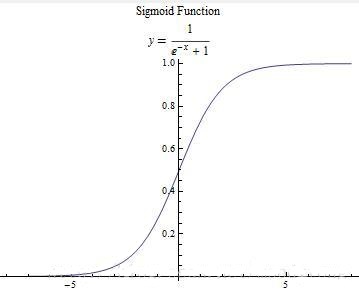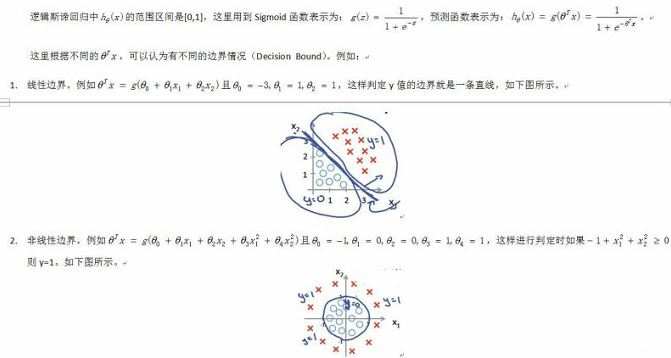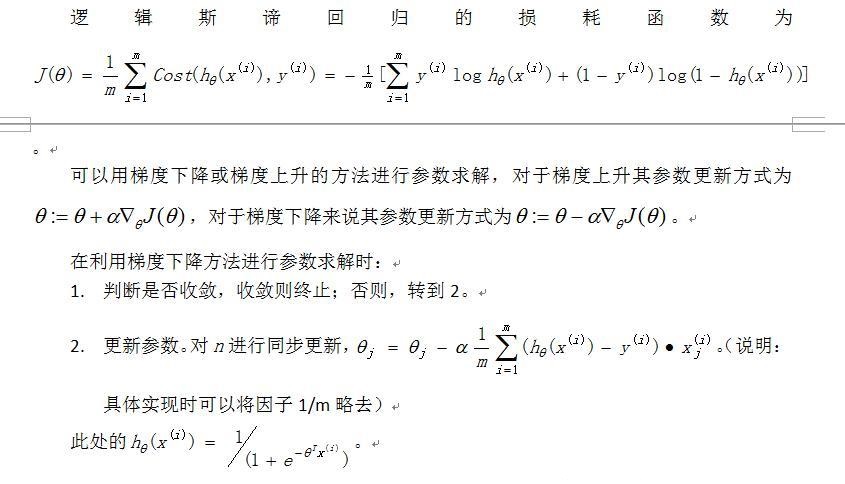一、算法简要
我们希望有这么一种函数:接受输入然后预测出类别,这样用于分类。这里,用到了数学中的sigmoid函数,sigmoid函数的具体表达式和函数图象如下:

可以较为清楚的看到,当输入的x小于0时,函数值<0.5,将分类预测为0;当输入的x大于0时,函数值>0.5,将分类预测为1。
1.1 预测函数的表示

1.2参数的求解

二、代码实现
函数sigmoid计算相应的函数值;gradAscent实现的batch-梯度上升,意思就是在每次迭代中所有数据集都考虑到了;而stoGradAscent0中,则是将数据集中的示例都比那里了一遍,复杂度大大降低;stoGradAscent1则是对随机梯度上升的改进,具体变化是alpha每次变化的频率是变化的,而且每次更新参数用到的示例都是随机选取的。
|
1
2
3
4
5
6
7
8
9
10
11
12
13
14
15
16
17
18
19
20
21
22
23
24
25
26
27
28
29
30
31
32
33
34
35
36
37
38
39
40
41
42
43
44
45
46
47
48
49
50
51
52
53
54
55
56
57
58
59
60
61
62
63
64
65
66
67
68
69
70
71
72
73
74
75
76
77
78
79
80
81
82
83
84
85
86
87
88
89
90
91
92
93
94
95
96
97
98
99
100
101
102
103
104
105
106
107
108
109
110
111
112
113
114
115
116
117
118
119
120
121
122
123
124
125
126
127
128
129
130
131
132
133
134
135
136
137
138
139
140
141
142
|
from numpy import *import matplotlib.pyplot as plt def loadDataSet(): dataMat = [] labelMat = [] fr = open('testSet.txt') for line in fr.readlines(): lineArr = line.strip('\n').split('\t') dataMat.append([1.0, float(lineArr[0]), float(lineArr[1])]) labelMat.append(int(lineArr[2])) fr.close() return dataMat, labelMat def sigmoid(inX): return 1.0/(1+exp(-inX)) def gradAscent(dataMatIn, classLabels): dataMatrix = mat(dataMatIn) labelMat = mat(classLabels).transpose() m,n=shape(dataMatrix) alpha = 0.001 maxCycles = 500 weights = ones((n,1)) errors=[] for k in range(maxCycles): h = sigmoid(dataMatrix*weights) error = labelMat - h errors.append(sum(error)) weights = weights + alpha*dataMatrix.transpose()*error return weights, errors def stoGradAscent0(dataMatIn, classLabels): m,n=shape(dataMatIn) alpha = 0.01 weights = ones(n) for i in range(m): h = sigmoid(sum(dataMatIn[i]*weights)) error = classLabels[i] - h weights = weights + alpha*error*dataMatIn[i] return weights def stoGradAscent1(dataMatrix, classLabels, numIter = 150): m,n=shape(dataMatrix) weights = ones(n) for j in range(numIter): dataIndex=range(m) for i in range(m): alpha= 4/(1.0+j+i)+0.01 randIndex = int(random.uniform(0,len(dataIndex))) h = sigmoid(sum(dataMatrix[randIndex]*weights)) error = classLabels[randIndex]-h weights=weights+alpha*error*dataMatrix[randIndex] del(dataIndex[randIndex]) return weights def plotError(errs): k = len(errs) x = range(1,k+1) plt.plot(x,errs,'g--') plt.show() def plotBestFit(wei): weights = wei.getA() dataMat, labelMat = loadDataSet() dataArr = array(dataMat) n = shape(dataArr)[0] xcord1=[] ycord1=[] xcord2=[] ycord2=[] for i in range(n): if int(labelMat[i])==1: xcord1.append(dataArr[i,1]) ycord1.append(dataArr[i,2]) else: xcord2.append(dataArr[i,1]) ycord2.append(dataArr[i,2]) fig = plt.figure() ax = fig.add_subplot(111) ax.scatter(xcord1, ycord1, s=30, c='red', marker='s') ax.scatter(xcord2, ycord2, s=30, c='green') x = arange(-3.0,3.0,0.1) y=(-weights[0]-weights[1]*x)/weights[2] ax.plot(x,y) plt.xlabel('x1') plt.ylabel('x2') plt.show() def classifyVector(inX, weights): prob = sigmoid(sum(inX*weights)) if prob>0.5: return 1.0 else: return 0def colicTest(ftr, fte, numIter): frTrain = open(ftr) frTest = open(fte) trainingSet=[] trainingLabels=[] for line in frTrain.readlines(): currLine = line.strip('\n').split('\t') lineArr=[] for i in range(21): lineArr.append(float(currLine[i])) trainingSet.append(lineArr) trainingLabels.append(float(currLine[21])) frTrain.close() trainWeights = stoGradAscent1(array(trainingSet),trainingLabels, numIter) errorCount = 0 numTestVec = 0.0 for line in frTest.readlines(): numTestVec += 1.0 currLine = line.strip('\n').split('\t') lineArr=[] for i in range(21): lineArr.append(float(currLine[i])) if int(classifyVector(array(lineArr), trainWeights))!=int(currLine[21]): errorCount += 1 frTest.close() errorRate = (float(errorCount))/numTestVec return errorRate def multiTest(ftr, fte, numT, numIter): errors=[] for k in range(numT): error = colicTest(ftr, fte, numIter) errors.append(error) print "There "+str(len(errors))+" test with "+str(numIter)+" interations in all!" for i in range(numT): print "The "+str(i+1)+"th"+" testError is:"+str(errors[i]) print "Average testError: ", float(sum(errors))/len(errors) ''''' data, labels = loadDataSet() weights0 = stoGradAscent0(array(data), labels) weights,errors = gradAscent(data, labels) weights1= stoGradAscent1(array(data), labels, 500) print weights plotBestFit(weights) print weights0 weights00 = [] for w in weights0: weights00.append([w]) plotBestFit(mat(weights00)) print weights1 weights11=[] for w in weights1: weights11.append([w]) plotBestFit(mat(weights11)) '''multiTest(r"horseColicTraining.txt",r"horseColicTest.txt",10,500) |
总结
以上就是本文关于机器学习经典算法-logistic回归代码详解的全部内容,希望对大家有所帮助。如有不足之处,欢迎留言指出。感谢朋友们对本站的支持!
原文链接:http://blog.csdn.net/moodytong/article/details/9731283










